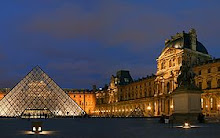THE GEDÄCHTNISKIRCHE is the symbolic centre of West Berlin and also the memorial to peace and reconciliation. After allied bombing during the WWII, the original west Tower has remained standing as a ruin. This is the only building on the square which was spared by the bombing and deliberately preserved. Built between 1891-95 in memory of Kaiser Wilhelm I, the first German Emperor, by Franz Schwechten in neo-romanesque style, it contains photographic exhibits of the Church and liturgical objects from bygone days and mosaics.
Wednesday, December 9, 2009
CHAPEL OF NOTRE DAME DU HAUT, RONCHAMP, FRANCE
Le Corbusier's "chapel of our lady of the height" is an excursion chapel designed in 1955
Tourists are attracted by the massive and curved walls. In addition it is so pleasant to admire at the vast shell of the concrete roof which give the building a massive, sculptural form. The exterior contrasts perfectly to the modest interior of the chapel.
Tourists are attracted by the massive and curved walls. In addition it is so pleasant to admire at the vast shell of the concrete roof which give the building a massive, sculptural form. The exterior contrasts perfectly to the modest interior of the chapel.
Tuesday, December 8, 2009
REICHSTAG DOME, BERLIN , GERMANY2
The dome is a luminous metal and glass structure with a ramp that spirals up a to a roof terrace with 360-degree views of central Berlin. The dome overlooks the debating chamber for the Bundestag and a central mirrored cone draws light into the plenary chamber. Foster was wined the Pritzker Prize in 1999 for his work on the building. The Bundestag parliament has become one of the top tourist destinations in Berlin. The line is very long winter as summer.
REICHSTAG DOME, BERLIN , GERMANY 1
By Norman Foster 1999.. The former home of German democracy was further damaged during Allied bombing of Berlin in World War II. It was left in this run until the 1960s, when it was opened as a conference center. The Reichstag was the site of the German reunification ceremonies at midnight on October 2, 1990. The Foster team's design focuses on making the processes of government more transparent
JEWISH MUSEUM, KREUZBERG BERLIN,GERMANY
Jewish Museum, Kreuzberg Berlin,Germany
By Daniel Libeskind 1998, the museum opened in 2001. This building looks unusual. The architect based his design on a moderately involved process of connecting lines between locations of historic events and locations of Jewish culture in Berlin. These lines form a basic outline and structure for the building. Libeskind also has used the concepts of absence, emptiness, and the invisible to design the building. He expresses the disappearance of Jewish culture in the city. One other detail is the window shape, which looks different and he zig-zagging zinc surface from the siding which remembers strangely containers.
By Daniel Libeskind 1998, the museum opened in 2001. This building looks unusual. The architect based his design on a moderately involved process of connecting lines between locations of historic events and locations of Jewish culture in Berlin. These lines form a basic outline and structure for the building. Libeskind also has used the concepts of absence, emptiness, and the invisible to design the building. He expresses the disappearance of Jewish culture in the city. One other detail is the window shape, which looks different and he zig-zagging zinc surface from the siding which remembers strangely containers.
HAUSE DER KULTUR DER WELT
Haus der Kulturen der Welt, Berlin-Tiergarten, Germany
The Congress Hall was the American contribution to the International Building Exhibition in 1957. It was declared as a gift of America to its close affiliate of West Berlin. Hugh A. Stubbins, Werner Düttmann and Franz Mocken, built a technically revolutionary building in 1957. I found the roof structure very artistic. The roof is supported on both sides by steel anchors which only rest on two points. In front of the building is an impressive large pond, in the middle of which Henry Moore's bronze sculpture "Big Butterfly" can be seen. The building is used as theater, exhibition area, congress and seminar.
The Congress Hall was the American contribution to the International Building Exhibition in 1957. It was declared as a gift of America to its close affiliate of West Berlin. Hugh A. Stubbins, Werner Düttmann and Franz Mocken, built a technically revolutionary building in 1957. I found the roof structure very artistic. The roof is supported on both sides by steel anchors which only rest on two points. In front of the building is an impressive large pond, in the middle of which Henry Moore's bronze sculpture "Big Butterfly" can be seen. The building is used as theater, exhibition area, congress and seminar.
Subscribe to:
Comments (Atom)
